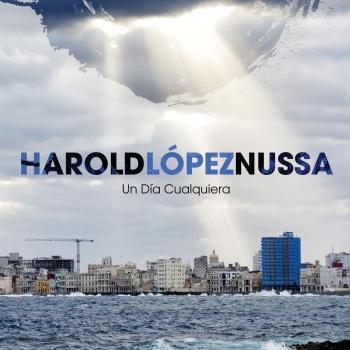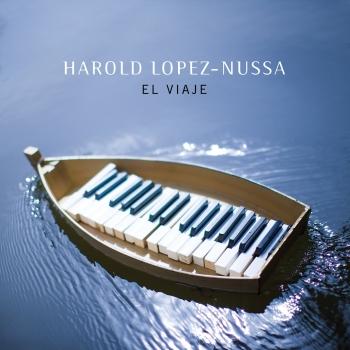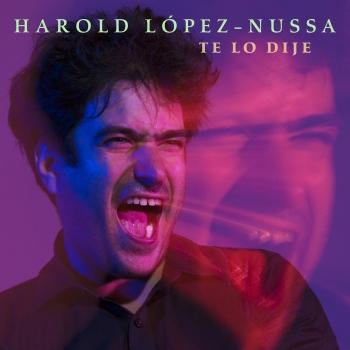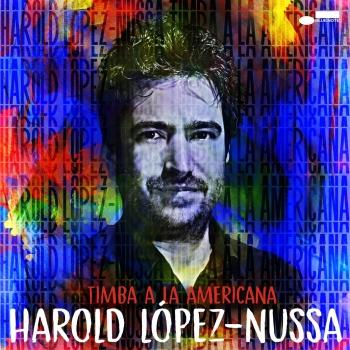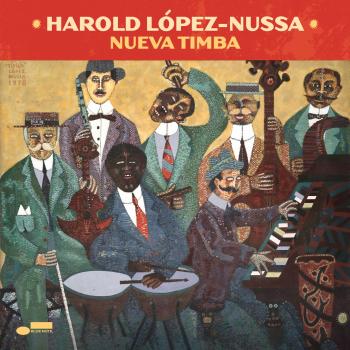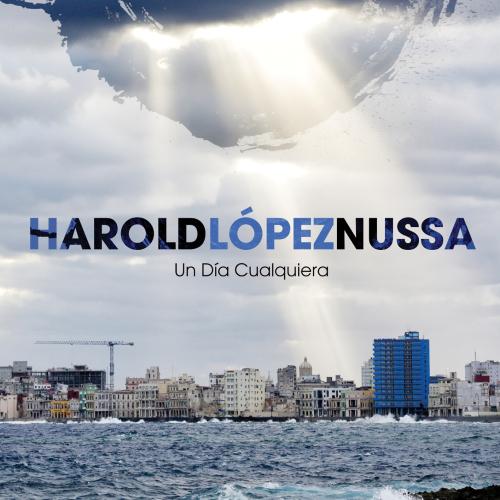
Un Día Cualquiera Harold López-Nussa
Album info
Album-Release:
2018
HRA-Release:
15.06.2018
Album including Album cover
- 1 Cimarrón 03:51
- 2 Danza de los Ñañigos 04:29
- 3 Una Tarde Cualquiera En Paris (to Bebo Valdes) 04:48
- 4 Preludio (to Jose Juan) 03:28
- 5 Elegua 05:06
- 6 Hialeah 03:32
- 7 Ma petite dans la Boulangerie 03:56
- 8 Y la Negra Bailaba 04:01
- 9 Conga Total / El Cumbanchero 03:39
- 10 Contigo en la Distancia 05:47
- 11 Mi Son Cerra’o 04:47
Info for Un Día Cualquiera
For more than a half-century, the embrace between Cuba and the United States has been subject to an odd dance of politics, including a still-standing embargo. Nevertheless, the bond between the two nations is deep and strong as ever, expressed most forcefully through the dance of culture—especially music.
It’s hard to imagine the U.S. jazz scene without the influence of the many Cuban musicians living here. Yet the musicians who remain in Cuba—whose relationship with jazz and other musical forms stays grounded in their native island’s cultural traditions and daily life—maintain a unique perspective. They tell a specific story.
Un Día Cualquiera, pianist Harold López-Nussa’s second release for Mack Avenue Records, represents this musical vantage point with force and innovation. He tells this story—his story—with drama, heartfelt emotion and consummate skills.
López-Nussa was born 1983 in Havana, where he still lives. “I need the kind of relaxed life that Havana gives me,” he said. For López-Nussa, whose award-winning music has led to international tours and who holds dual citizenship in Cuba and France. “Every time I return to Cuba, I feel something special—not just a connection with my family and friends, but with the place itself. This is where my music comes from, what it talks about.”
His previous Mack Avenue album, El Viaje (The Journey), was released on the heels of President Obama’s historic 2016 visit to Havana, against a backdrop of newly relaxed trade and travel restrictions. Un Día Cualquiera arrives as U.S. restrictions regarding Cuba again tighten under the Trump administration; considered in that light, the album is an affirmative statement that music will always cross borders and defy obstacles. “I want to grow closer to the American people,” López-Nussa said. “This has always been an important desire for Cubans, especially musicians. It’s impossible for us to be separate because we have so much in common, so much to share.”
Musically, Lopez-Nussa’s last album augmented his band with additional instruments and influences, including Senegalese bassist Alune Wade, to achieve a globalized sound. For “Un Día Cualquiera,” Lopéz-Nussa sticks to his core trio, with his younger brother Ruy Adrián López-Nussa on drums and percussion, and bassist Gaston Joya—a group the pianist first convened a decade ago in Cuba.
Harold López-Nussa, piano
Gaston Joya, bass
Ruy Adrian López-Nussa, drums, percussion
Produced by Swami Jr.
Harold Lopez-Nussa
For more than a half-century, the embrace between Cuba and the United States has been subject to an odd dance of politics, including a still-standing embargo. Nevertheless, the bond between the two nations is deep and strong as ever, expressed most forcefully through the dance of culture—especially music.
It’s hard to imagine the U.S. jazz scene without the influence of the many Cuban musicians living here. Yet the musicians who remain in Cuba—whose relationship with jazz and other musical forms stays grounded in their native island’s cultural traditions and daily life—maintain a unique perspective. They tell a specific story.
Un Día Cualquiera, pianist HAROLD LÓPEZ-NUSSA‘s second release for Mack Avenue Records, represents this musical vantage point with force and innovation. He tells this story—his story—with drama, heartfelt emotion and consummate skills.
López-Nussa was born 1983 in Havana, where he still lives. “I need the kind of relaxed life that Havana gives me,” he said. For López-Nussa, whose award-winning music has led to international tours and who holds dual citizenship in Cuba and France. “Every time I return to Cuba, I feel something special—not just a connection with my family and friends, but with the place itself. This is where my music comes from, what it talks about.”
His previous Mack Avenue album, El Viaje (The Journey), was released on the heels of President Obama’s historic 2016 visit to Havana, against a backdrop of newly relaxed trade and travel restrictions. Un Día Cualquiera arrives as U.S. restrictions regarding Cuba again tighten under the Trump administration; considered in that light, the album is an affirmative statement that music will always cross borders and defy obstacles. “I want to grow closer to the American people,” López-Nussa said. “This has always been an important desire for Cubans, especially musicians. It’s impossible for us to be separate because we have so much in common, so much to share.”
Musically, Lopez-Nussa’s last album augmented his band with additional instruments and influences, including Senegalese bassist Alune Wade, to achieve a globalized sound. For “Un Día Cualquiera,” Lopéz-Nussa sticks to his core trio, with his younger brother Ruy Adrián López-Nussa on drums and percussion, and bassist Gaston Joya—a group the pianist first convened a decade ago in Cuba.
“These are my closest friends and two of the greatest musicians of my generation in Cuba,” he said. “We’ve played a lot together through the years, but this is the first time that we’ve toured and recorded as a working trio. When we play to together, something special always happens and I feel comfortable and free, because they know how my music works and where I will go even before I get there.”
The island of Cuba is dotted with families known for musical achievement. López-Nussa grew up in one such home. On May 18, 2018, Washington D.C.’s Kennedy Center will pay tribute to this legacy within its sprawling “Artes de Cuba Festival” through a concert showcasing the Lopéz-Nussa family. Harold Lopéz-Nussa and his brother will perform alongside their father, Ruy López-Nussa, an esteemed drummer and educator, and their uncle, Ernán López-Nussa, an acclaimed pianist. (Their late mother, Mayra Torres, was a highly regarded piano teacher.)
Harold López-Nussa’s music reflects the full range and richness of Cuban music, with its distinctive combination of classical, folkloric and popular elements, as well as its embrace of jazz improvisation and interaction. His career gracefully spans styles. Early on, he recorded Heitor Villa-Lobos ́ Fourth Piano Concerto with Cuba’s National Symphony Orchestra (2003) and won First Prize at the Jazz Solo Piano Competition at the Montreux Jazz Festival, Switzerland (2005). He was featured on the album Ninety Miles, playing alongside jazz stars David Sánchez, Christian Scott and Stefon Harris, and Esencial (of compositions by revered Cuban classical guitarist, composer and conductor Leo Brouwer). He spent three years in the touring band of the beloved Cuban singer Omara Portuondo.
At the age of eight, López-Nussa began studying at the Manuel Saumell Elementary School of Music, then the Amadeo Roldán Conservatory and finally graduating with a degree in classical piano from the Instituto Superior de Artes (ISA). On two tracks here, he dips into the repertoire of Ernest Lecuona—“one of the greatest Cuban composers of all time,” he said, who, like Gershwin in the U.S., brought indigenous and popular forms to bear on classical repertoire. Lopez-Nussa’s interpretations of “Danza de los Ñañigos,” which is based on Afro-Cuban religious rituals, and “Y la Negra Bailaba,” which, he said, “is somewhere between Cuban son and danzón styles,” represent less liberties taken than the unfolding of a deep understanding of Lecuona’s towering legacy.
López-Nussa grew up in Centro Habana, a neighborhood known for its folkloric Afro-Cuban ceremonies. “There would be two or three ceremonies each week, and I could hear them from my house,” he recalled. “What I soaked in there has never left me.” His original composition, “Elegua,” translates batá drum rhythms and chants for a Yoruba deity to a jazz-trio format, and forms one of the album’s dramatic high points.
The ease and invention with which he improvises at the piano, and the suppleness with which his trio swings make it hard to believe that López-Nussa didn’t really take up jazz until he was 18 years old. “Jazz was scary,” he said. “Improvisation was scary.” Yet he felt emboldened by Herbie Hancock’s 1996 album, The New Standard, of jazz interpretations of pop, rock and R&B songs. “That gave me new ideas about what was possible, and what I could do,” he said. He found inspiration, too, from Cuba’s great jazz pianists—the ongoing work of the reigning master Chucho Valdés, as well as recordings of Chucho’s father, the late Bebo Valdés. Here, López-Nussa’s composition, “Una Tarde Cualquiera en Paris,” pays homage to the calm, reflective quality of Bebo’s pianism. Another López-Nussa original, “Mi Son Cerra’o” is meant to evoke the sound and spirit of the early descargas (jam sessions) on which Bebo played, the earliest Cuban jazz recordings. López-Nussa’s tender rendition of “Contigo en la Distancia” a bolero written by Cuban singer-songwriter César Portillo de la Luz in 1946 (covered in the decades since by singers ranging from Plácido Domingo to Christina Aguilera) reveals lessons learned on bandstands accompanying Omara Portuondo. “She showed me how to put all of your passion, your whole existence, into a single song,” he said.
Un Día Cualquiera is a forceful statement from a Cuban musician leading his tight-knit Cuban band, recorded in the U.S. (at WGBH Studios in Boston, Mass.), and influenced by music from both countries in ways that transcend narrow notions of “Latin jazz.” The album nods to classic Cuban composers and musicians but it focuses mostly on pianist Harold López-Nussa’s original compositions and his distinctive trio concept. These compositions are mostly new, save for one or two, such as the opener, “Cimarrón,” which are older pieces reinvented for the present moment.
López-Nussa chose the new album’s title, which means “Just Another Day,” because, he said, “the idea is to put the music and the trio together in a studio and just play, the way we three do every day, any day—like a concert in the living room of your house.”
This album contains no booklet.









